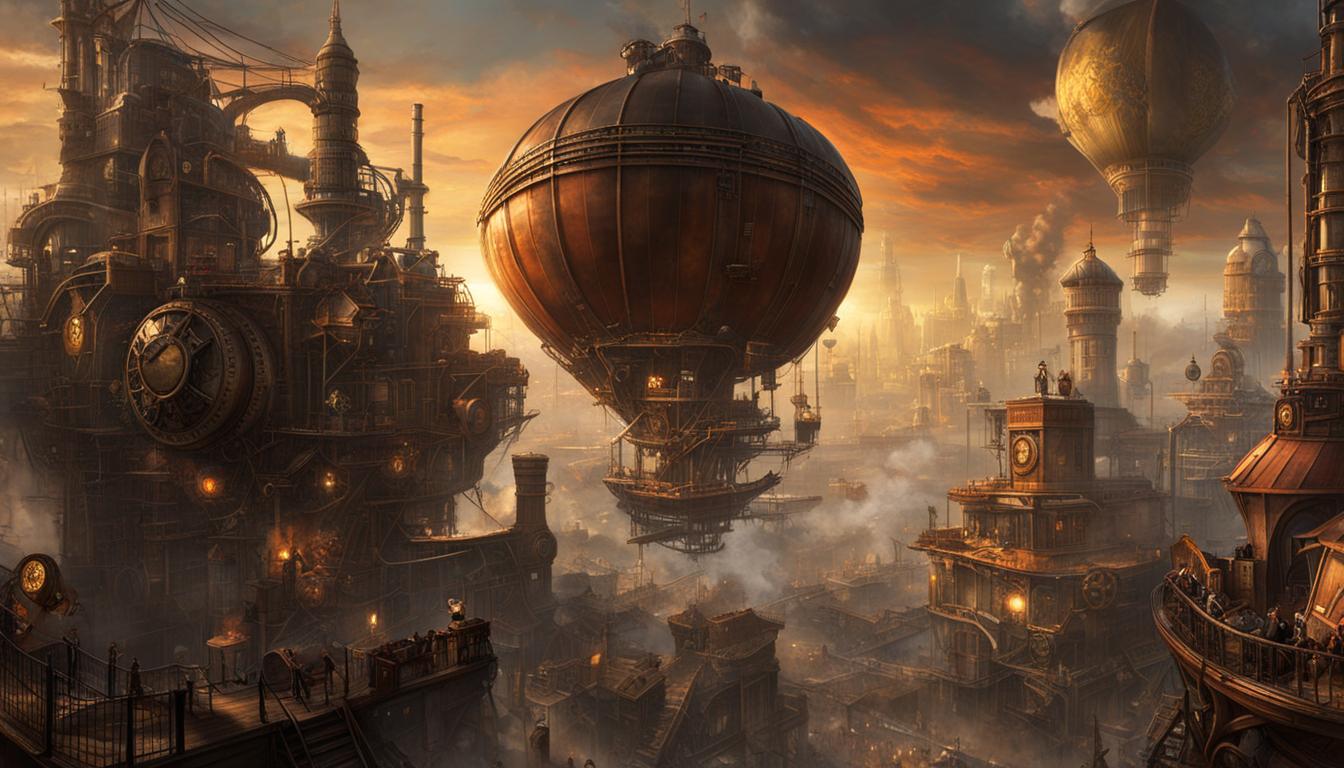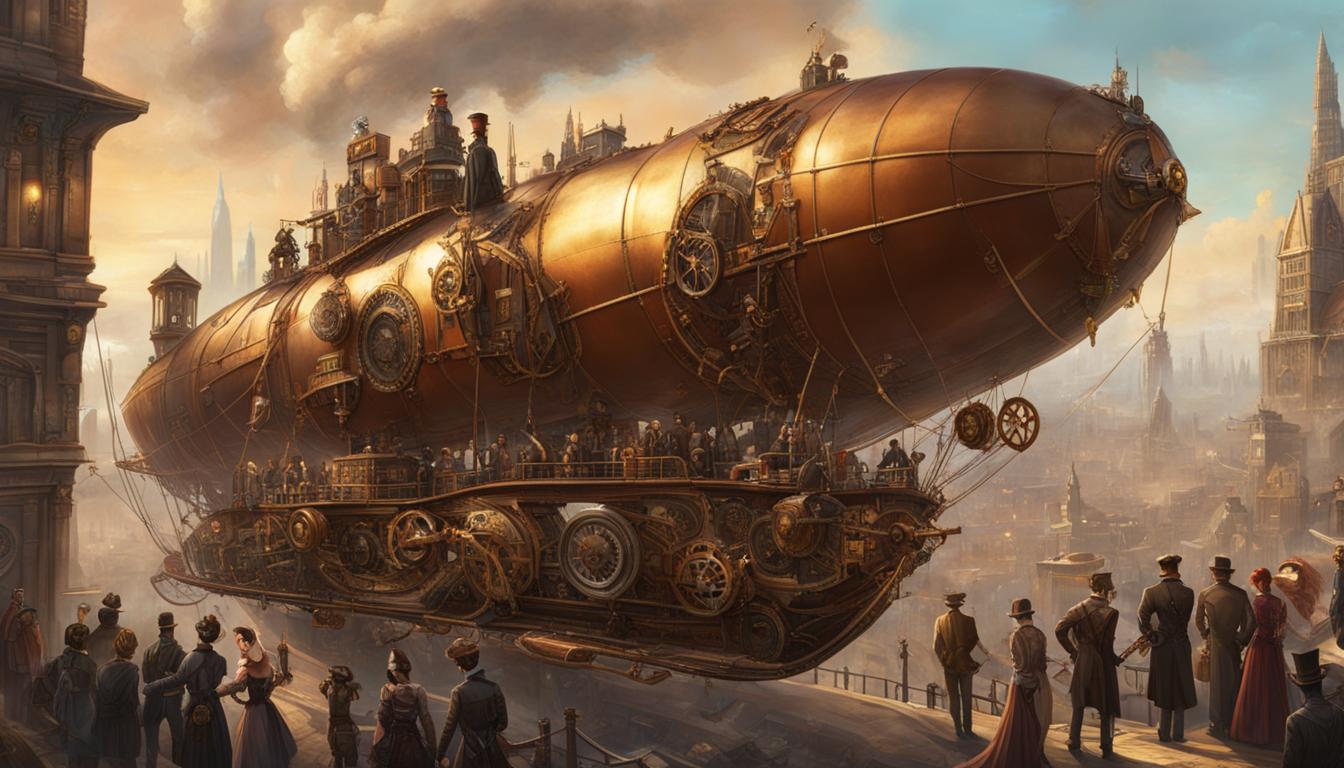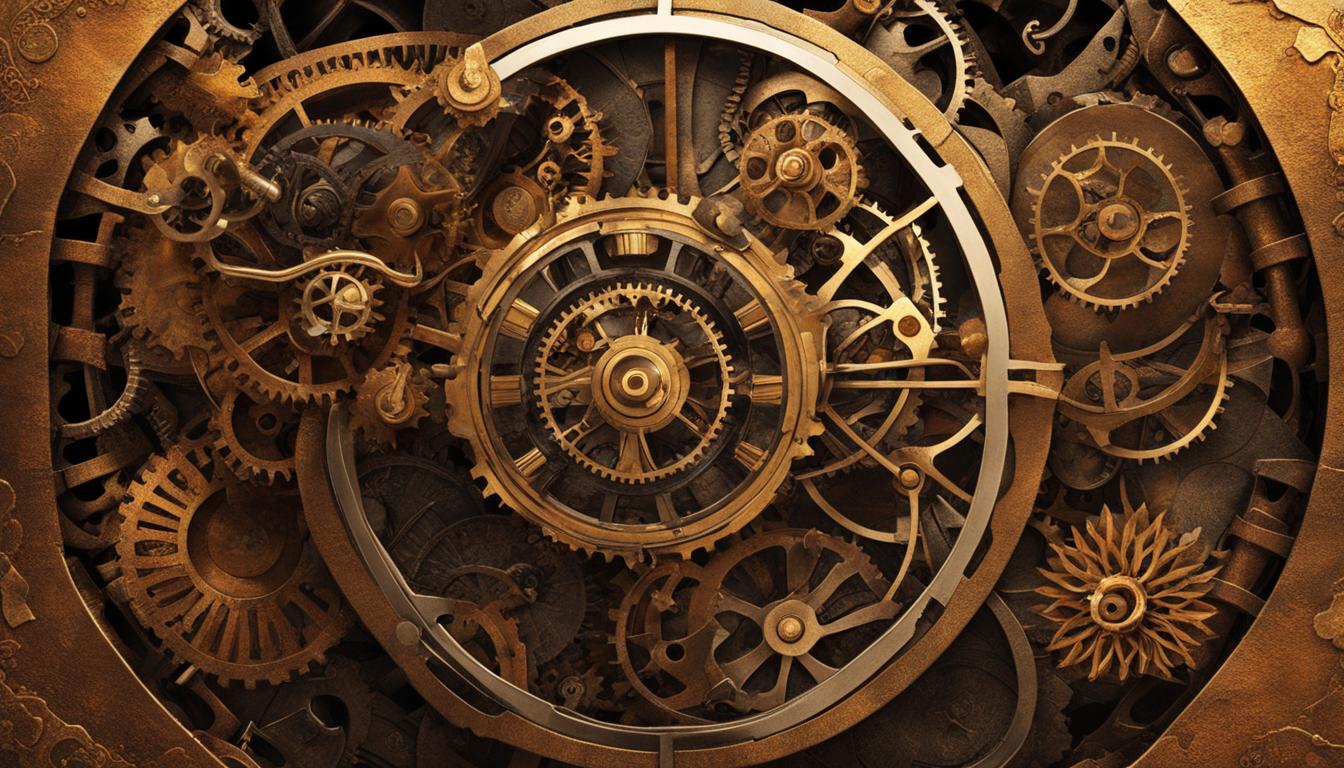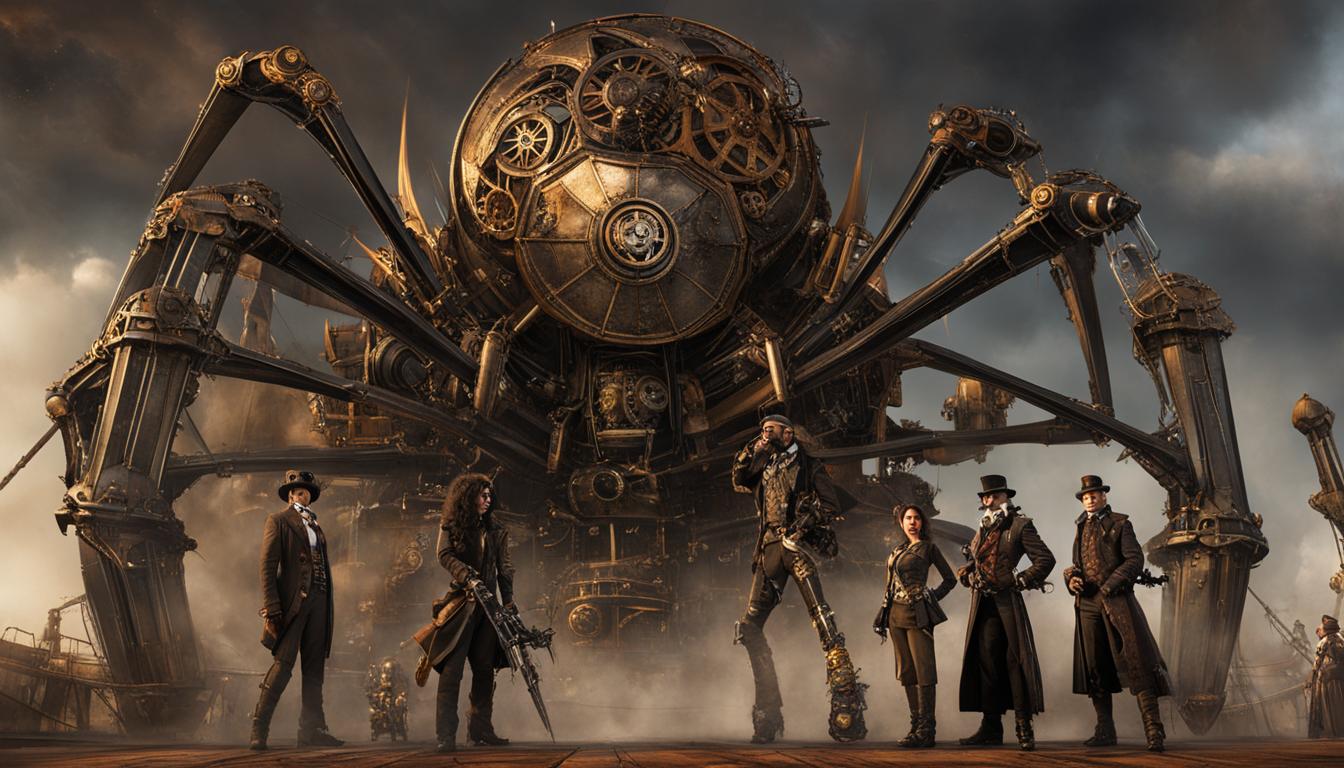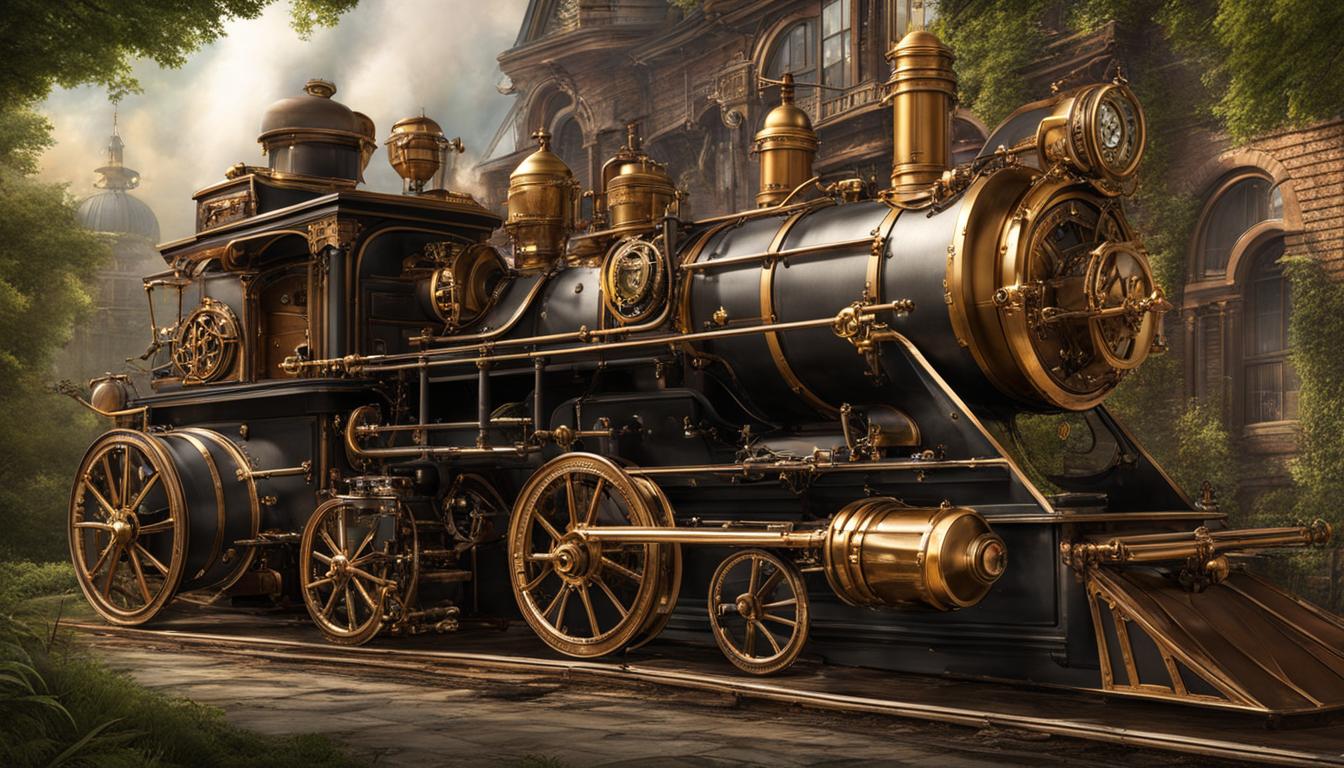Steampunk, the subgenre of science fiction, takes readers on a thrilling journey through a retrofuturistic world where Victorian aesthetics meet imaginative inventions. In this whimsical realm, technology is powered by steam, and creativity knows no bounds. The role of invention in steampunk lore is pivotal, as it drives the narratives and unveils a unique take on technological innovations.
Steampunk draws inspiration from 19th-century industrial steam-powered machinery and the works of esteemed authors like Jules Verne and H.G. Wells. It celebrates the ingenuity and imagination of inventors, presenting alternative futures or pasts that intertwine with real-world social issues.
Key Takeaways:
- Steampunk is a subgenre of science fiction that incorporates retrofuturistic technology and aesthetics.
- Inventions play a crucial role in shaping the steampunk narratives and exploring alternative futures or pasts.
- The genre draws inspiration from authors like Jules Verne and H.G. Wells, presenting creative takes on historical innovations.
- Steampunk inventors are portrayed as ingenious individuals whose creations drive the plot forward.
- Steampunk offers readers a fresh perspective on technological innovations and the possibilities of invention.
The Historical Roots of Steampunk
Steampunk is a genre that draws inspiration from 19th-century scientific romances, particularly the works of Jules Verne and H.G. Wells. It takes readers on a journey through retrofuturistic worlds where steam power remains prevalent and technological advancements have taken unique and imaginative forms. In steampunk narratives, the significance of inventions cannot be underestimated. These inventions play a central role in shaping the stories, offering a fresh perspective on groundbreaking innovations.
Steampunk authors present a creative take on historical inventions, reimagining them in fantastical and whimsical ways. Steam-powered machines and devices, such as airships and analog computers, populate the pages of steampunk literature. These contraptions showcase the authors’ imaginative prowess and their ability to push the boundaries of what is historically known.
Steampunk celebrates the ingenuity of inventors, portraying them as creative and ingenious individuals who drive the plot forward with their groundbreaking inventions.
The genre also explores alternative histories where steam power has remained prominent, posing intriguing “what if” scenarios. Through these narratives, readers are invited to ponder the impact of technology on society and the possibilities of invention.
| Invention | Description |
|---|---|
| Steam Cannon | A powerful weapon that harnesses the pressure of steam to launch projectiles with great force. |
| Airship | A majestic vessel that travels through the skies using buoyant gases, providing a means of transportation or exploration. |
| Mechanical Computer | Analog computing device inspired by Charles Babbage’s Analytical Engine, capable of performing complex calculations. |
Steampunk narratives delve into the realms of imagination and creativity, presenting readers with a unique blend of historical references and inventive twists. The significance of inventions in these stories not only adds depth to the plots but also offers a celebration of the ingenuity and innovative spirit of the human mind.
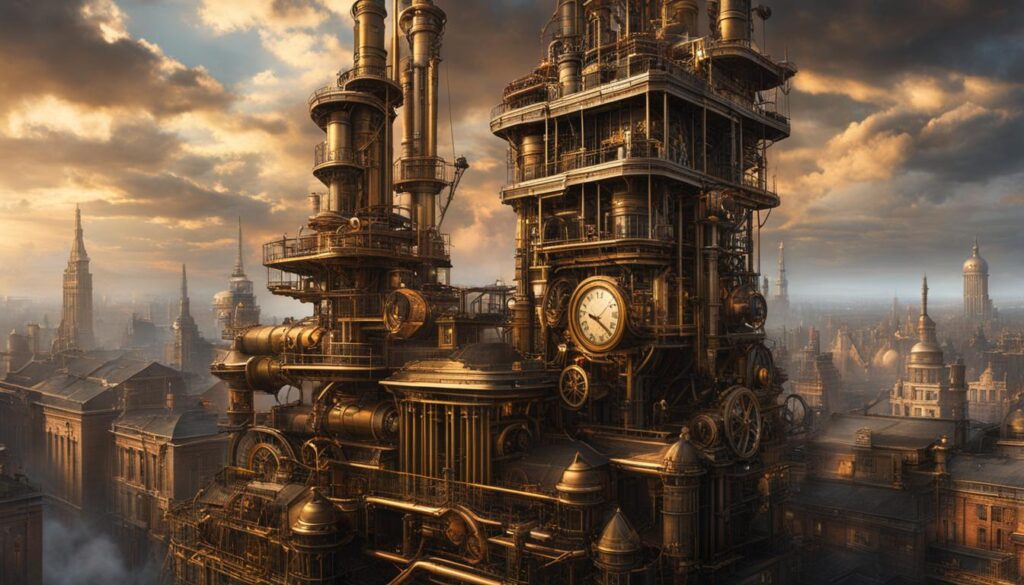
Steampunk-Inspired Inventions and Contraptions
Steampunk literature is renowned for its creative and imaginative takes on inventions, showcasing technological wonders that defy the conventions of the Victorian era. From steam cannons and airships to analog and even mechanical computers like Charles Babbage’s Analytical Engine, the genre presents a plethora of unique and intricate contraptions.
One of the iconic inventions in steampunk literature is the steam-powered airship. These majestic vessels glide through the skies, propelled by the power of steam and clockwork mechanisms. Their elaborate designs and ornate details make them a visually striking presence in the fictional worlds they inhabit.
“The airship, with its massive bronze propellers and gleaming brass exterior, soared through the clouds, a testament to the ingenuity of its inventor. Steam billowed from its engines, propelling it forward with a rhythmic hiss, while passengers marveled at the breathtaking view from its panoramic windows.”
Steampunk is also known for its exploration of mechanical marvels, such as automatons and clockwork creatures. These intricately crafted beings blur the line between art and technology, showcasing the ingenuity and craftsmanship of their creators. From lifelike humanoid automatons to fantastical clockwork animals, these inventions captivate readers with their intricate movements and attention to detail.
Another fascinating aspect of steampunk inventions is the incorporation of historical elements and real-world advancements. Authors often take inspiration from the past and reimagine historical innovations with a steampunk twist. For example, the genre may reimagine Thomas Edison’s phonograph as a steam-powered music player, or Nikola Tesla’s experiments with electricity as a source of power for arcane devices.
Technological Wonders in Steampunk Literature
Steampunk literature dazzles readers with its technological wonders, offering a glimpse into a world where creative minds have harnessed the power of steam to create awe-inspiring inventions. These technological marvels not only serve as captivating plot devices but also reflect the genre’s fascination with the fusion of science and imagination.
- Steampunk’s creative takes on inventions provide readers with a fresh perspective on what could have been if the Industrial Revolution had taken a different turn.
- The intricate mechanisms and attention to detail in steampunk contraptions showcase the ingenuity of their inventors.
- Through vivid descriptions, readers can almost hear the clanking of gears, the hiss of steam, and the hum of machinery as they are transported to a world where technology is both familiar and fantastical.
- These technological wonders serve as a reminder of the limitless possibilities of invention and inspire readers to embrace their own creativity.
A Table of Steampunk-Inspired Inventions and their Functions
| Invention | Function |
|---|---|
| Steam-Powered Airship | Transportation and exploration of the skies |
| Automatons | Perform tasks, entertain, and assist |
| Steam Cannons | Powerful weaponry for defense and offense |
| Analog Computers | Complex calculations and data processing |
| Mechanical Exoskeletons | Enhance physical strength and mobility |
| Arcane Power Generators | Provide a source of energy using mystical elements |
The Role of Inventors in Steampunk Stories
In the rich and imaginative world of steampunk stories, inventors hold a special place. These creative and ingenious individuals are the driving force behind the narrative, shaping the story with their groundbreaking inventions. Steampunk celebrates the inventors and their role in pushing the boundaries of technology in its unique and retrofuturistic settings.
Steampunk stories often portray inventors as brilliant and visionary individuals who possess the ability to craft intricate and functional machines. They are masters of their craft, combining their knowledge of mechanics, engineering, and steam power to create awe-inspiring contraptions. These inventors bring a sense of wonder and curiosity to the narrative, injecting it with a sense of creativity and imagination.
As the story unfolds, inventors in steampunk face challenges and obstacles that test their skills and determination. Their inventions become integral to the plot, serving as catalysts for adventure and conflict. Whether it’s a steam-powered airship, a mechanical automaton, or a complex analytical engine, the inventions of steampunk inventors not only propel the story forward but also become characters in their own right.
Table: Steampunk Inventors and Their Notable Creations
| Inventor | Notable Creations |
|---|---|
| Professor Alexander Hartley | Steam-powered Analytical Engine, Time-Traveling Chrono-Carriage |
| Victoria Evergreen | Aether-Powered Ghost Detector, Skyward Goggles |
| Frederick Whittaker | The Steam Cannon, Mechanical Exoskeleton |
Steampunk’s celebration of inventions and the role of inventors adds depth and excitement to the genre. It showcases the power of human creativity and ingenuity, reminding us of the profound impact invention can have on society and the world at large. Steampunk invites readers into a world where the possibilities of technology truly know no bounds, and where inventors are the heroes of their own extraordinary tales.
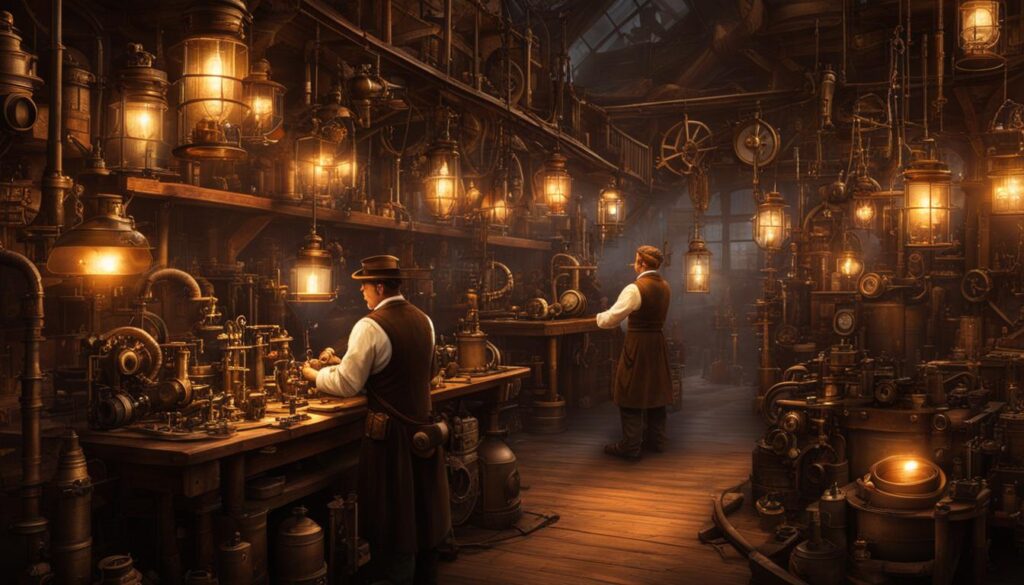
Steampunk’s Take on Technological Innovations
In the world of steampunk, technological innovations are not constrained by historical limitations. Instead, the genre takes a creative and imaginative approach to inventions, presenting an alternative reality where steam power reigns supreme and fantastical contraptions come to life. Steampunk authors draw inspiration from real-world advancements and reframe them in a retrofuturistic context, showcasing their unique perspectives on groundbreaking inventions.
“In steampunk, innovation knows no bounds. It is a realm where Victorian aesthetics blend seamlessly with futuristic possibilities,” says renowned steampunk author, Amelia Gears. “We explore what could have been, what might still be, and challenge the boundaries of what is considered possible.”
Steampunk narratives often feature an array of imaginative inventions, from steam-driven airships that dominate the skies to intricate clockwork automatons that shape the society. These technological marvels not only serve as plot devices but also offer readers a fresh perspective on the potential of invention. Through rich descriptions and intricate details, steampunk authors bring these contraptions to life, inviting readers to immerse themselves in a world where creativity and innovation know no limits.
One of the most captivating aspects of steampunk’s take on technological innovations is how it reflects and comments on real-world advancements. By reimagining historical inventions and pushing them to new heights, steampunk offers a commentary on the impact of technology on society. It prompts us to ponder the possibilities of alternative paths and how they may have shaped our world today. Steampunk’s unique blend of history and imagination creates a thought-provoking narrative landscape, where the boundaries of scientific progress are redefined.
Steampunk’s Perspectives on Groundbreaking Inventions
| Invention | Real-World Inspiration | Steampunk Adaptation |
|---|---|---|
| Telegraph | Samuel Morse’s telegraph | The Opti-Send System: A telegraph powered by steam and gears, transmitting messages through a network of pneumatic tubes. |
| Electricity | Thomas Edison’s electric power generation and distribution | The Lumino Dynamo: A device that harnesses the power of steam to generate electricity, illuminating cities with its dazzling glow. |
| Automobile | Karl Benz’s first practical automobile | The SteamKnight: A steam-powered, armored vehicle capable of traversing any terrain and defending against threats. |
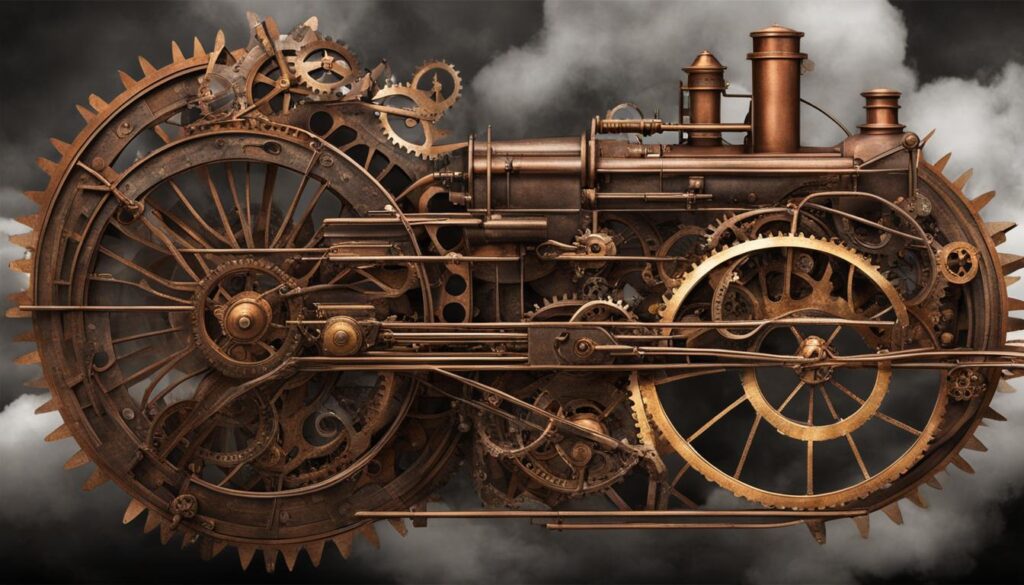
Steampunk’s perspectives on groundbreaking inventions captivate readers with their blend of historical inspiration and fantastic reimagining. The genre pushes the boundaries of what is known and sparks the imagination, inviting us to explore worlds where steam power rules and innovation knows no limits.
The Importance of Innovation in Steampunk Tales
Innovation is the lifeblood of steampunk tales, fueling the imagination and driving the narratives forward. In this genre, inventiveness is celebrated, and authors go to great lengths to envision new and exciting creations within the constraints of the Victorian era. Steampunk literature thrives on the ingenuity of its writers, who craft intricate and fantastical inventions that captivate readers and transport them to a world where creativity knows no bounds.
Steampunk stories often use invention as a means to solve problems and overcome challenges. Whether it’s a steam-powered airship soaring through the sky or a mechanical marvel that defies conventional logic, these innovative creations play a vital role in shaping the plot. They provide a sense of wonder and awe, immersing readers in a world where technological marvels abound.
But innovation in steampunk goes beyond just the gadgets and contraptions. It permeates every aspect of the narrative, from the social structures to the political landscapes. Steampunk authors use their creative prowess to imagine alternative histories and explore the consequences of technological advancements. They delve into the moral and ethical implications of these inventions, offering readers a thought-provoking and intellectually stimulating experience.
| Innovation in Steampunk | Description |
|---|---|
| Steam-powered machinery | One of the defining features of steampunk is the use of steam as a power source for machinery and devices. This retrofuturistic element adds a sense of nostalgia and reimagines the potential of steam power in a world where technology took a different path. |
| Anachronistic technologies | Steampunk authors often incorporate anachronistic technologies into their narratives, introducing inventions that are far beyond what was possible during the Victorian era. These anachronistic technologies add an element of surprise and wonder to the story, pushing the boundaries of what is historically known. |
| Creative adaptations | Steampunk is known for its creative adaptations of historical innovations. Authors take inspiration from real-world inventions and reimagine them in a steampunk setting, showcasing their unique vision and adding a fresh twist to familiar concepts. |
In conclusion, innovation is a cornerstone of steampunk tales, driving the narratives forward and captivating readers with its imaginative inventions. From steam-powered marvels to alternative histories shaped by technological advancements, steampunk offers a unique and thought-provoking perspective on the importance of innovation. It’s a genre that celebrates creativity, pushing the boundaries of what is possible and inspiring readers to imagine a world where ingenuity reigns supreme.
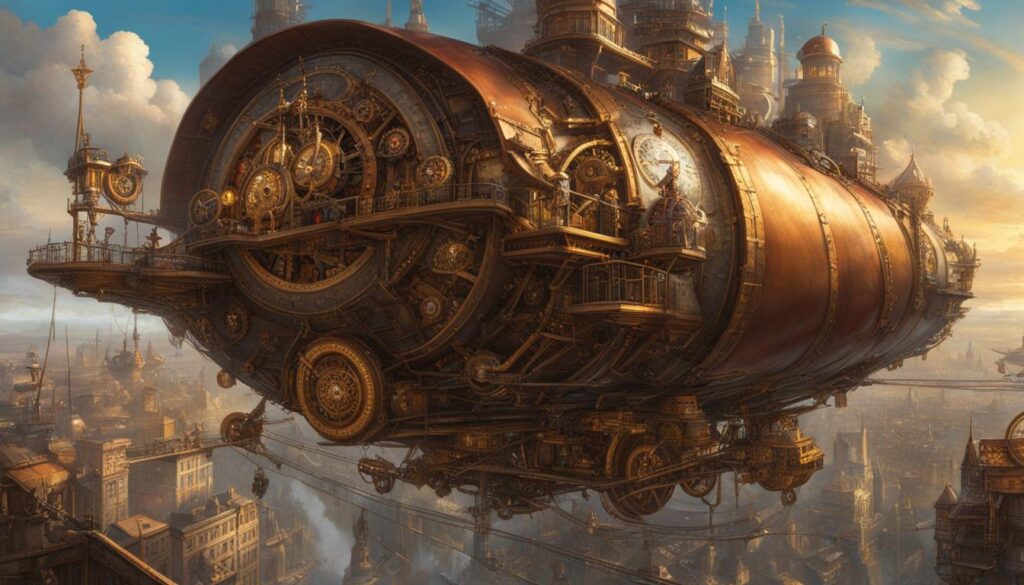
Steampunk’s Imaginative Takes on Historical Innovations
Steampunk literature is renowned for its creative and imaginative reimagining of historical innovations. Authors in this genre draw inspiration from real-world inventions and advancements, transforming them into fantastical and whimsical creations that captivate readers. By infusing these historical innovations with steampunk aesthetics and technologies, they offer a unique and refreshing perspective on the possibilities of invention.
One example of steampunk’s creative takes on historical innovations is the steam-powered airship. In the real world, airships were a significant technological development during the late 19th and early 20th centuries. However, in the steampunk realm, they are elevated to new heights, featuring intricate designs, ornate detailing, and breathtaking functionality. These airships become symbols of adventure and exploration, offering readers a glimpse into a world fueled by steam power and boundless imagination.
“Steampunk’s imaginative takes on historical innovations transport readers to a world where the possibilities of invention are limitless.”
Another example is the mechanical computer, inspired by Charles Babbage’s Analytical Engine. In steampunk literature, these mechanical computers are transformed into towering marvels of gears and cogs, capable of complex calculations and computations. They blend the elegance of Victorian aesthetics with the ingenuity of modern computing, expanding the boundaries of what was historically known and creating a thrilling fusion of past and future.
Table: Steampunk’s Creative Takes on Historical Innovations
| Innovation | Real-World Version | Steampunk Version |
|---|---|---|
| Airship | Real-world airships were a significant technological development during the late 19th and early 20th centuries. | In steampunk literature, airships are transformed into intricate and ornate creations, symbolizing adventure and exploration. |
| Mechanical Computer | Charles Babbage’s Analytical Engine was a mechanical precursor to modern computers. | In steampunk literature, mechanical computers are towering marvels of gears and cogs, fusing Victorian aesthetics with modern computing. |
| Automaton | Historically, automatons were mechanical devices capable of performing tasks with precise movements. | In steampunk literature, automatons are transformed into whimsical creations with intricate mechanisms and personalities. |
Steampunk’s imaginative takes on historical innovations transport readers to a world where the possibilities of invention are limitless. By reimagining real-world inventions and infusing them with steampunk aesthetics and technologies, authors in this genre create a captivating and immersive reading experience. These creative interpretations of historical innovations showcase the genre’s ability to push the boundaries of imagination and inspire readers to rethink the possibilities of technology.
Conclusion
Steampunk is a genre that transports readers to a world where imagination and innovation reign. Drawing inspiration from the 19th-century scientific romances of authors like Jules Verne and H.G. Wells, steampunk celebrates the role of invention in its narratives. It envisions a reality where steam power remains prevalent, allowing for unique and creative inventions that shape the stories in captivating ways.
Inventors play a crucial role in driving the narrative forward, showcasing their ingenuity and creative brilliance. They are the visionary creators who push the boundaries of technology, solving problems and overcoming challenges with their extraordinary inventions. Steampunk not only highlights the significance of innovation but also explores its impact on society, offering readers a thought-provoking exploration of the relationship between technology and humanity.
One of the remarkable aspects of steampunk is its imaginative takes on historical innovations. The genre reimagines real-world inventions, pushing the boundaries of what is historically known and expanding the realm of possibilities. It invites readers to envision a world where the possibilities of technology are endless and where creativity flourishes.
In the world of steampunk, invention is celebrated as a catalyst for adventure, exploration, and societal change. It encourages readers to embrace their own creativity and to consider the power of innovation in shaping our world. Steampunk’s unique blend of history, fantasy, and technology captivates readers and offers a fresh perspective on the possibilities of invention.
FAQ
What is steampunk?
Steampunk is a subgenre of science fiction that incorporates retrofuturistic technology and aesthetics inspired by 19th-century industrial steam-powered machinery.
What is the significance of invention in steampunk narratives?
Invention plays a crucial role in steampunk stories, driving the plot forward and solving problems. Steampunk celebrates the role of invention in shaping its narratives.
What are some examples of steampunk-inspired inventions?
Steampunk literature features a wide range of inventions, from steam cannons and airships to analog and mechanical computers. These imaginative creations showcase the author’s creative vision.
How does steampunk portray inventors?
Steampunk often presents inventors as creative and ingenious individuals who push the boundaries of technology. Inventors play a crucial role in driving the narrative forward and are celebrated in steampunk stories.
How does steampunk explore technological innovations?
Steampunk presents an alternative history where advancements in Victorian-era technology have led to fantastical inventions. It offers readers a fresh perspective on the possibilities of technology and invention.
Why is innovation important in steampunk tales?
Innovation is vital in steampunk tales as it drives the plot forward, helps overcome challenges, and showcases the inventiveness of the characters. Steampunk celebrates the importance of innovation in shaping its narratives.
How does steampunk reimagine historical innovations?
Steampunk takes historical inventions and reimagines them in a fantastical and imaginative way. It offers readers unique versions of real-world advancements, expanding the possibilities of technology in its narratives.

